
Fullhale Ciphaler
Ask a doctor about a prescription for Fullhale Ciphaler

How to use Fullhale Ciphaler
Leaflet accompanying the packaging: patient information
Fullhale Ciphaler, (50 micrograms + 250 micrograms)/dose, inhalation powder,
divided
Fullhale Ciphaler, (50 micrograms + 500 micrograms/dose, inhalation powder, divided
Salmeterol + Fluticasone propionate
You should carefully read the contents of the leaflet before using the medicine, as it contains important information for the patient.
- You should keep this leaflet, so that you can read it again if necessary.
- In case of any doubts, you should consult a doctor or pharmacist.
- This medicine has been prescribed to a specific person. It should not be given to others. The medicine may harm another person, even if the symptoms of their illness are the same.
- If the patient experiences any side effects, including any side effects not listed in this leaflet, they should tell their doctor or pharmacist. See section 4.
Table of contents of the leaflet
- 1. What is Fullhale Ciphaler and what is it used for
- 2. Important information before using Fullhale Ciphaler
- 3. How to use Fullhale Ciphaler
- 4. Possible side effects
- 5. How to store Fullhale Ciphaler
- 6. Contents of the packaging and other information
1. What is Fullhale Ciphaler and what is it used for
Fullhale Ciphaler contains two medicines – salmeterol and fluticasone propionate:
- Salmeterol is a long-acting bronchodilator. Bronchodilators help to maintain the patency of the airways in the lungs. This makes it easier for air to flow in and out of the lungs. The effect lasts for at least 12 hours.
- Fluticasone propionate is a corticosteroid that reduces swelling and irritation of the lungs.
The doctor has prescribed this medicine to the patient to prevent breathing disorders such as:
- asthma
- chronic obstructive pulmonary disease (COPD). Salmeterol with fluticasone propionate, in a dose of 50 micrograms + 500 micrograms, reduces the number of exacerbations of COPD symptoms.
Fullhale Ciphaler should be used daily as recommended by the doctor. This will ensure proper control of asthma or COPD.
Fullhale Ciphaler prevents the occurrence of shortness of breath and wheezing. However, it should not be used to control sudden attacks of shortness of breath or wheezing.
In the event of such an attack, it is necessary to use a rapidly acting bronchodilator, such as salbutamol, immediately. The patient should always carry such a medicine with them.
2. Important information before using Fullhale Ciphaler
When not to use Fullhale Ciphaler:
- if the patient is allergic to salmeterol, fluticasone propionate, or any other ingredient, lactose monohydrate.
Warnings and precautions
Before starting to use Fullhale Ciphaler, the patient should discuss with their doctor if they have:
- heart disease, including irregular or rapid heartbeat
- hyperthyroidism
- high blood pressure
- diabetes (Fullhale Ciphaler may increase blood glucose levels)
- low potassium levels in the blood
- tuberculosis currently being treated or a history of tuberculosis or other lung infections
If the patient experiences blurred vision or other vision disturbances, they should contact their doctor.
Children and adolescents
Fullhale Ciphaler should not be used in children under 12 years of age.
Fullhale Ciphaler and other medicines
The patient should tell their doctor or pharmacist about all medicines they are currently taking or have recently taken, as well as any medicines they plan to take, including asthma medicines and any over-the-counter medicines. Fullhale Ciphaler should not be used with certain other medicines.
Before starting to use Fullhale Ciphaler, the patient should inform their doctor about taking the following medicines:
- beta-blockers (e.g., atenolol, propranolol, and sotalol). Beta-blockers are most commonly used to treat high blood pressure or other heart diseases.
- medicines used to treat infections (e.g., ketoconazole, itraconazole, and erythromycin), including some medicines used to treat HIV infections (e.g., ritonavir, cobicistat-containing products). Some of these medicines may increase the levels of fluticasone propionate or salmeterol in the body. This may increase the risk of side effects of Fullhale Ciphaler, including irregular heartbeat, or may worsen existing side effects. The doctor may want to closely monitor the patient's condition when taking such medicines.
- Corticosteroids (orally or by injection). If the patient has recently taken such medicines, it may increase the risk of adrenal gland disorders caused by Fullhale Ciphaler.
- Diuretics used to treat high blood pressure.
- Other bronchodilators (such as salbutamol).
- Xanthine derivatives. They are often used to treat asthma.
Pregnancy and breastfeeding
If the patient is pregnant or breastfeeding, thinks they may be pregnant, or plans to have a child, they should consult their doctor or pharmacist before using this medicine.
Driving and using machines
It is unlikely that Fullhale Ciphaler will affect the ability to drive or use machines, unless side effects such as blurred vision occur.
Fullhale Ciphaler contains lactose
Each delivered dose of Fullhale Ciphaler contains 12 mg of lactose monohydrate. This amount usually does not cause problems in people with lactose intolerance. The excipient lactose monohydrate contains small amounts of milk proteins, which may cause allergic reactions.
3. How to use Fullhale Ciphaler
This medicine should always be used as recommended by the doctor or pharmacist. In case of doubts, the patient should consult their doctor or pharmacist.
- Fullhale Ciphaler should be used daily, until the doctor recommends stopping its use. The patient should not take a higher dose than recommended. In case of doubts, they should consult their doctor or pharmacist.
- The patient should not stop using Fullhale Ciphaler or reduce the dose without consulting their doctor.
- Fullhale Ciphaler should be inhaled into the lungs through the mouth.
- The patient may not be able to feel the taste or sensation of the powder on the tongue, even if the inhaler is used correctly.
Asthma
Adults and adolescents over 12 years of age
- Fullhale Ciphaler 50 micrograms + 250 micrograms - one inhalation twice a day
- Fullhale Ciphaler 50 micrograms + 500 micrograms - one inhalation twice a day
Use in children
It is not recommendedto use Fullhale Ciphaler in children under 12 years of age.
Adults with chronic obstructive pulmonary disease (COPD)
- Fullhale Ciphaler 50 micrograms + 500 micrograms - one inhalation twice a day
If the asthma symptoms are well-controlled while using Fullhale Ciphaler twice a day, the doctor may recommend reducing the frequency of use to once a day. The dose may be changed to:
- once a day, in the evening - if the patient's symptoms occur at night,
- once a day, in the morning - if the patient's symptoms occur during the day.
It is very important that the doctor instructs the patient on how many inhalations and how often to use.
If the patient is using Fullhale Ciphaler for asthma, the doctor will regularly check the symptoms.
In the event of worsening asthma symptoms or difficulty breathing, the patient should immediately contact their doctor.
The patient should continue using Fullhale Ciphaler, but should not increase the number of inhalations. The symptoms of the disease may worsen, and the patient's condition may deteriorate. The patient should contact their doctor, as they may need additional treatment.
Instructions for use
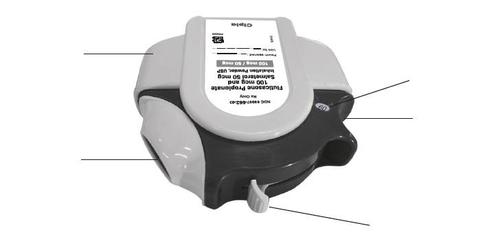
Body
Counter
Thumb grip
Mouthpiece
Lever
- The doctor, nurse, or pharmacist should train the patient in using the inhaler. They should also periodically check how the patient uses the inhaler. Using Fullhale Ciphaler incorrectly or not as recommended by the doctor may cause the medicine to not produce the expected improvement in asthma or COPD.
- The inhaler contains blisters with Fullhale Ciphaler powder.
- At the top of the inhaler, there is a dose counter that indicates how many doses of the medicine are left. See Fig. A. The counter counts down to 0. The numbers from 5 to 0 appear in red to warn that there are only a few doses of the medicine left in the inhaler. If the counter shows 0, it means that the inhaler is empty.

Fig. A
Using the inhaler
- 1. To open the Fullhale Ciphaler inhaler, the patient should hold the body with one hand and place their thumb on the thumb grip. Push the thumb as far as possible - until it clicks. See Fig. B. The patient will hear a click. A small opening will appear in the mouthpiece.
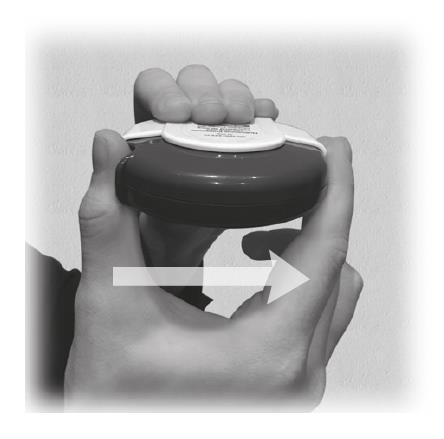
Fig. B
- 2. The patient should hold the inhaler with the mouthpiece facing them. They can hold it in their right or left hand. Slide the lever as far as possible - until it clicks. See Fig. C. The patient will hear a click. A dose of the medicine will be placed in the mouthpiece. Each time the lever is slid, a blister opens inside, and a dose of powder is prepared for inhalation. The patient should not unnecessarily use the lever, as this will cause the opening of subsequent blisters and waste of the medicine.

Fig. C
- 3. The patient should hold the inhaler at a distance from their mouth and exhale slowly without feeling uncomfortable. They should not exhale into the inhaler. See Fig. D.
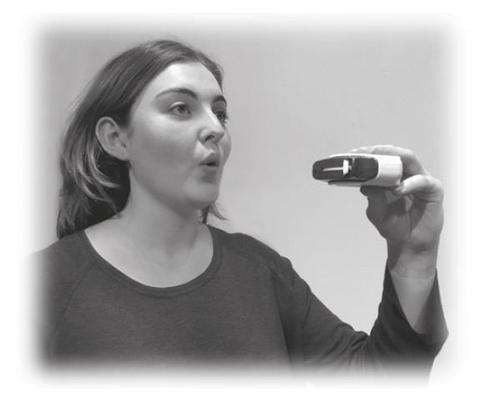
Fig. D
- 4. The patient should put the mouthpiece in their mouth. They should take a slow and deep breath in through the inhaler, not through their nose. See Fig. E.
Remove the inhaler from the mouth.
Hold the breath for about 10 seconds or as long as it is comfortable.
Exhale slowly.
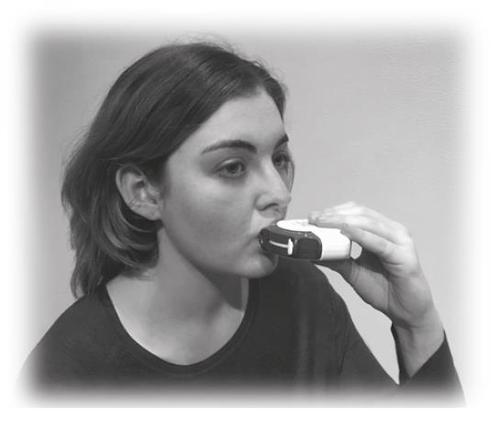
Fig. E
- 5. After inhaling the medicine, the patient should rinse their mouth with water and spit it out and (or) brush their teeth. This may help prevent the occurrence of thrush and hoarseness.
- 6. To close the inhaler, the patient should slide the thumb grip back - until it clicks.
The lever will now return to its original position and will be reset. See Fig. F.
The inhaler is now ready for reuse.
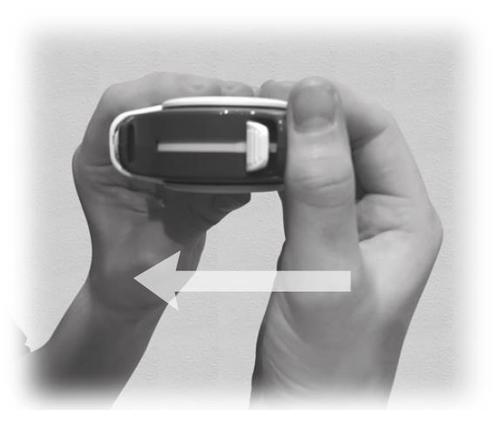
Fig. F
As with all inhalers, caregivers should ensure that children prescribed Fullhale Ciphaler use the correct inhalation technique, as described above.
Cleaning the inhaler
The patient should wipe the mouthpiece of the Fullhale Ciphaler inhaler with a dry cloth or tissue.
Using a higher dose of Fullhale Ciphaler than recommended
It is important to use the inhaler as instructed. If a higher dose than recommended is used accidentally, the patient should tell their doctor or pharmacist. The following may occur: faster than normal heartbeat, tremors, dizziness, headache, weakness, and joint pain.
In the event of using higher doses for a long period, the patient should contact their doctor or pharmacist for advice, as high doses of Fullhale Ciphaler may cause a decrease in the production of steroid hormones by the adrenal glands.
Missing a dose of Fullhale Ciphaler
The patient should not take a double dose to make up for a missed dose. They should take the next dose at the usual time.
Stopping the use of Fullhale Ciphaler
It is very important to take Fullhale Ciphaler daily as recommended. The patient should take the medicine until their doctor recommends stopping it. The patient should not suddenly stop taking Fullhale Ciphaler or reduce the dose, as the symptoms of the disease may worsen.
Additionally, sudden stopping or reduction of the dose of Fullhale Ciphaler may (very rarely) cause adrenal gland disorders (adrenal insufficiency), which can sometimes cause side effects.
These side effects may include:
- abdominal pain
- fatigue and loss of appetite, nausea
- vomiting and diarrhea
- weight loss
- headache or drowsiness
- low blood sugar
- low blood pressure and seizures
When the body is under stress, such as due to fever, injury (e.g., a car accident), infection, or surgery, adrenal insufficiency may worsen, and any of the above side effects may occur.
If the patient experiences any of these side effects, they should tell their doctor or pharmacist. To prevent the occurrence of these symptoms, the doctor may prescribe additional corticosteroids in the form of tablets (e.g., prednisolone).
In case of any further doubts about the use of this medicine, the patient should consult their doctor, pharmacist, or nurse.
4. Possible side effects
Like all medicines, this medicine can cause side effects, although not everybody gets them.
To minimize the risk of side effects, the doctor will recommend the smallest dose of Fullhale Ciphaler that controls asthma or COPD.
Allergic reactions: The patient may experience sudden difficulty breathing immediately after using Fullhale Ciphaler
The patient should stop using Fullhale Ciphalerand immediately contact their doctor. Allergic reactions to Fullhale Ciphaler are uncommon (may occur in less than 1 in 100 people).
Pneumonia (lung infection) in patients with chronic obstructive pulmonary disease (COPD) (common side effect)
The patient should tell their doctorif they experience any of the following symptoms, which may be signs of a lung infection:
- fever or chills
- increased production of sputum or change in its color
- worsening cough or increased difficulty breathing
Other side effects are listed below:
Very common (may occur in more than 1 in 10 people)
- Headache - usually decreases as treatment continues.
- Increased frequency of colds has been reported in patients with chronic obstructive pulmonary disease (COPD).
Common (may occur in less than 1 in 10 people)
- Thrush (painful, creamy-white patches) in the mouth and throat, as well as pain in the tongue, hoarseness, and irritation of the throat. Rinsing the mouth with water and spitting it out and (or) brushing the teeth after each inhalation may be helpful. The doctor may recommend an antifungal medicine to treat thrush.
- Pain, swelling of the joints, and muscle pain.
- Muscle spasms.
The following side effects have been reported in patients with chronic obstructive pulmonary disease (COPD):
- bruising and fractures
- sinusitis (feeling of tension and fullness in the nose, cheeks, and eyes, sometimes with a pulsating headache)
- low potassium levels in the blood (the patient may experience irregular heartbeat, muscle weakness, and spasms)
Uncommon (may occur in less than 1 in 100 people)
- Increased blood sugar (glucose) levels (hyperglycemia). In patients with diabetes, it may be necessary to monitor blood sugar levels more frequently and adjust the dose of antidiabetic medicines.
- Cataract (clouding of the lens of the eye).
- Very fast heartbeat (tachycardia).
- Feeling of trembling and fast or irregular heartbeat (palpitations) - these symptoms usually are not serious and decrease as treatment continues.
- Chest pain.
- Anxiety (this side effect occurs mainly in children).
- Sleep disturbances.
- Allergic skin rash.
Rare (may occur in less than 1 in 1000 people)
Difficulty breathing or wheezing worsening immediately after taking Fullhale Ciphaler
The patient should stop using Fullhale Ciphaler, use a rapidly acting inhalation medicine to facilitate breathing, and immediately contact their doctor.
- Fullhale Ciphaler may disrupt the normal production of steroid hormones by the body, especially when taking high doses of the medicine for a long period. The symptoms include:
- slowed growth in children and adolescents
- decreased bone mass
- glaucoma
- weight gain
- rounding of the face (moon face, Cushing's syndrome)
The doctor will regularly check for these side effects and ensure that the patient is using the smallest dose of Fullhale Ciphaler that controls their asthma.
- Changes in behavior, such as excessive excitement and irritability (these symptoms occur mainly in children).
- Irregular heartbeat or extra heartbeats (arrhythmias). The patient should tell their doctor about this, but should not stop using Fullhale Ciphaler unless the doctor recommends it.
- Fungal infection of the esophagus, which can cause difficulty swallowing.
Frequency not known (cannot be estimated from the available data):
- Depression or aggression. The occurrence of these side effects is more likely in children.
- Blurred vision
Reporting side effects
If the patient experiences any side effects, including any side effects not listed in this leaflet, they should tell their doctor or pharmacist. Side effects can be reported directly to the Department of Drug Safety Monitoring of the Office for Registration of Medicinal Products, Medical Devices, and Biocidal Products: Al. Jerozolimskie 181C, 02-222 Warsaw, phone: 22 49-21-301, fax: 22 49-21-309, website: https://smz.ezdrowie.gov.pl
Side effects can also be reported to the marketing authorization holder or its representative.
Reporting side effects will help to gather more information on the safety of this medicine.
5. How to store Fullhale Ciphaler
- The medicine should be stored out of sight and reach of children.
- The patient should not use this medicine after the expiry date stated on the carton and inhaler label after: EXP. The expiry date refers to the last day of the month stated.
- The patient should not store it in the refrigerator or freeze it.
- The shelf life after opening the foil bag is 2 months. The patient should store the opened inhaler at a temperature below 25°C.
- Medicines should not be disposed of via wastewater or household waste. The patient should ask their pharmacist how to dispose of medicines that are no longer needed. This will help protect the environment.
6. Contents of the packaging and other information
What Fullhale Ciphaler contains
- The active substances of the medicine are salmeterol and fluticasone propionate. Each single inhalation provides a dose (dose leaving the mouthpiece) of 47 micrograms of salmeterol (as salmeterol xinafoate) and 231 or 460 micrograms of fluticasone propionate. This is equivalent to a delivered dose of 50 micrograms of salmeterol (as salmeterol xinafoate) and 250 or 500 micrograms of fluticasone propionate.
- The other ingredient is lactose monohydrate (which contains milk proteins). See section 2.
What Fullhale Ciphaler looks like and contents of the pack
- Fullhale Ciphaler is supplied in a ruby-red and white plastic inhaler for single use, containing a strip with 60 evenly spaced blisters filled with white or off-white powder. The inhaler is packed in a foil bag, which is placed in a cardboard box.
- Each dose is divided.
Fullhale Ciphaler is available in a pack containing 1 inhaler. Each inhaler contains 60 inhalations.
Marketing authorization holder and importer
Marketing authorization holder
ELC Group s.r.o.
Pobřežní 394/12,
Karlín, Prague 8,
186 00
Czech Republic
phone: +420 22 491 0000
Importer
Cipla Europe NV
De Keyserlei
58-60 box 19
2018 Antwerp
Belgium
This medicine is authorized in the Member States of the European Economic Area under the following names:
| Sweden | Salmeterol/Flutikason ELC Group 50 microgram/250 microgram/dose inhalation powder |
| Salmeterol/Flutikason ELC Group 50 microgram/500 microgram/dose inhalation powder | |
| Norway | Salmeterol/flutikason ELC |
| Salmeterol/flutikason ELC | |
| Italy | Salmeterolo e Fluticasone Teva Italia 50 micrograms/250 micrograms per dose, powder for inhalation, pre-dosed |
| Salmeterolo e Fluticasone Teva Italia 50 micrograms/500 micrograms per dose, powder for inhalation, pre-dosed | |
| France | propionate de fluticasone/salmétérol ELC Ciphaler 250 micrograms/50 micrograms/dose, powder for inhalation in a single-dose container |
| propionate de fluticasone/salmétérol ELC Ciphaler 500 micrograms/50 micrograms/dose, powder for inhalation in a single-dose container | |
| Poland | Fullhale Ciphaler |
| Fullhale Ciphaler | |
| Austria | Salmeterol/Fluticason G.L. 50 micrograms/250 micrograms single-dose powder for inhalation |
| Salmeterol/Fluticason G.L. 50 micrograms/500 micrograms single-dose powder for inhalation | |
| Romania | Zoreeda Ciphaler 50 micrograms/250 micrograms inhalation powder |
| Zoreeda Ciphaler 50 micrograms/500 micrograms inhalation powder | |
| Belgium | Fullhale Ciphaler 50 micrograms/250 micrograms per dose inhalation powder, pre-dosed |
| Fullhale Ciphaler 50 micrograms/500 micrograms per dose inhalation powder, pre-dosed | |
| Czech Republic | Zoreeda Ciphaler |
| Zoreeda Ciphaler | |
| Slovakia | Zoreeda Ciphaler 50 micrograms/250 micrograms single-dose inhalation powder |
| Zoreeda Ciphaler 50 micrograms/500 micrograms single-dose inhalation powder | |
| Denmark | Zoreeda Ciphaler 50 micrograms/250 micrograms per dose inhalation powder in Diskos |
| Zoreeda Ciphaler 50 micrograms/500 micrograms per dose inhalation powder in Diskos |
Date of last revision of the leaflet:12.2024
- Country of registration
- Active substance
- Prescription requiredYes
- ImporterCipla Europe NV G.L. Pharma GmbH
- This information is for reference only and does not constitute medical advice. Always consult a licensed doctor before taking any medication. Oladoctor is not responsible for medical decisions based on this content.
- Alternatives to Fullhale CiphalerDosage form: Powder, 50 mcg + 250 mcgActive substance: salmeterol and fluticasoneManufacturer: Aeropharm GmbHPrescription requiredDosage form: Powder, 50 mcg + 500 mcgActive substance: salmeterol and fluticasoneManufacturer: Aeropharm GmbHPrescription requiredDosage form: Powder, (50 micrograms + 500 micrograms)/doseActive substance: salmeterol and fluticasonePrescription required
Alternatives to Fullhale Ciphaler in other countries
The best alternatives with the same active ingredient and therapeutic effect.
Alternative to Fullhale Ciphaler in Spain
Alternative to Fullhale Ciphaler in Ukraine
Online doctors for Fullhale Ciphaler
Discuss dosage, side effects, interactions, contraindications, and prescription renewal for Fullhale Ciphaler – subject to medical assessment and local rules.














